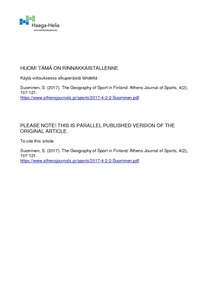The Geography of Sport in Finland
Suominen, Seppo (2017)
Suominen, Seppo
Athens Institute for Education and Research
2017
https://creativecommons.org/licenses/by-nc/4.0/
Julkaisun pysyvä osoite on
https://urn.fi/URN:NBN:fi:amk-2017121921928
https://urn.fi/URN:NBN:fi:amk-2017121921928
Tiivistelmä
The main purpose of this study is to answer: Why do teams survive in some locations? How many top teams can a particular town can sustain? How differentiated are these towns in terms of different sports?. The purpose is thus to link geography and the number of teams in a town. The monopolistic competition of Dixit and Stiglitz (1977) seems to be compatible with the sports geography in Finland. Location attributes and team success are important in determining attendance. These are in the long run the major determinants of survival in the highest level of any ball game in Finland. Geography is related to town population and their incomes.
The Dixit-Stiglitz model also proposes that the attendance or the number of spectators is more related and correlated with the cost structure of the team than with the population statistics. The results seem to verify this hypothesis. The monopolistic competition model is tested with Finnish data covering 26 seasons starting in 1990. The data incorporates top team playing in the highest men’s league. These popular ball games in this study are ice hockey, football, baseball, floorball, volleyball and basketball. Two estimation methods are used. The Poisson regression and Negative Binomial regression both yield similar results. A larger town in terms of population is able to sustain a larger number of different sports while the average income of citizens is negatively related to the number of sport teams in that town. It is also true that the biggest city of a region seems to cannibalise its neighbouring towns and these have a smaller number of teams.
The Dixit-Stiglitz model also proposes that the attendance or the number of spectators is more related and correlated with the cost structure of the team than with the population statistics. The results seem to verify this hypothesis. The monopolistic competition model is tested with Finnish data covering 26 seasons starting in 1990. The data incorporates top team playing in the highest men’s league. These popular ball games in this study are ice hockey, football, baseball, floorball, volleyball and basketball. Two estimation methods are used. The Poisson regression and Negative Binomial regression both yield similar results. A larger town in terms of population is able to sustain a larger number of different sports while the average income of citizens is negatively related to the number of sport teams in that town. It is also true that the biggest city of a region seems to cannibalise its neighbouring towns and these have a smaller number of teams.
